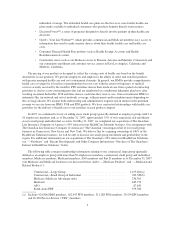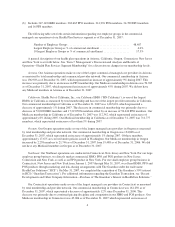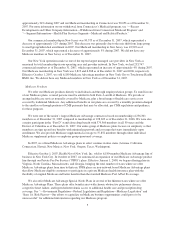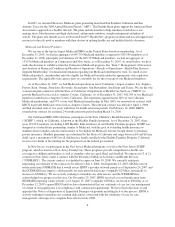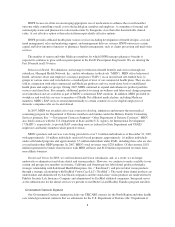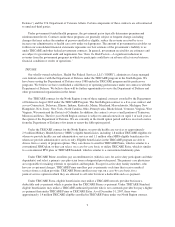Health Net 2007 Annual Report Download - page 15
Download and view the complete annual report
Please find page 15 of the 2007 Health Net annual report below. You can navigate through the pages in the report by either clicking on the pages listed below, or by using the keyword search tool below to find specific information within the annual report.ability to interact with employers, members and other third parties (including health care professionals) via the
Internet has become a more important competitive factor. To that end, we have made technology investments to
enhance our electronic interactions with third parties. We believe that we compete effectively against other health
care industry participants in the states in which we operate.
Our primary competitors in California are Kaiser Permanente, Blue Cross of California, UnitedHealth
Group, Inc. and Blue Shield of California. Together, these four plans and Health Net account for a majority of the
insured market in California. Kaiser is the largest HMO in California based on number of enrollees and Blue
Cross of California is the largest PPO provider in California based on number of enrollees. There are also a
number of small, regional-based health plans that compete with Health Net in California, mainly in the small
business group market segment. In addition, two of the major national managed care companies, Aetna, Inc. and
CIGNA Corp., are active in California. Their respective commercial full-risk market share is not as significant as
our primary competitors in California and we believe that each remains in California primarily to serve their
national, self-funded accounts’ California employees.
Our largest competitor in Arizona is Blue Cross Blue Shield of Arizona. Our Arizona HMO also competes
with UnitedHealth Group Inc., CIGNA, Aetna and Humana Inc. Our Oregon health plan competes primarily
against Kaiser, UnitedHealth Group, Providence, Regence Blue Cross/Blue Shield, PacificSource and Lifewise.
In the Northeast, our Connecticut health plan competes for business with Aetna, WellPoint, Inc. (Anthem
BCBS), ConnectiCare, Inc., UnitedHealth Group, Inc. (UnitedHealthcare/Oxford Health Plans), and CIGNA. Our
main competitors in New York are UnitedHealth Group, Inc. (UnitedHealthcare/Oxford Health Plans),
WellPoint, Inc. (Empire Blue Cross Blue Shield), Aetna, HIP/GHI and CIGNA. Our main competitors in New
Jersey are UnitedHealth Group, Inc. (UnitedHealthcare/Oxford Health Plans), Horizon Blue Cross Blue Shield,
Aetna and CIGNA.
Marketing and Sales
We market our products and services to individuals and employer groups through inside sales staff,
independent brokers, agents and consultants and through the Internet. For our group health business, we market
our products and services utilizing a three-step process. We first market to potential employer groups, group
insurance brokers and consultants. We then provide information directly to employees once the employer has
selected our health coverage. Finally, we engage members and employers in marketing for member and group
retention. For our small group business, members are enrolled by their employer based on the plan chosen by the
employer. In general, once selected by a large employer group, we solicit enrollees from the employee base
directly. During “open enrollment” periods when employees are permitted to change health care programs, we
use a variety of techniques to attract new enrollees, including, without limitation, direct mail, work day and
health fair presentations and telemarketing. Our sales efforts are supported by our marketing division, which
engages in product research and development, multicultural marketing, advertising and communications, and
member education and retention programs.
Premiums for each employer group are generally contracted on a yearly basis and are payable monthly. We
consider numerous factors in setting our monthly premiums, including employer group needs and anticipated
health care utilization rates as forecasted by us based on the demographic composition of, and our prior
experience in, our service areas. Premiums are also affected by applicable regulations that in certain
circumstances prohibit experience rating of group accounts (i.e., setting the premium for the group based on its
past use of health care services) and by state regulations governing the manner in which premiums are structured.
In some of our markets we sell individual policies, which are generally sold through independent brokers
and agents. In some states, carriers are allowed to individually underwrite these policies (i.e. select applicants to
whom coverage will be provided and others who are denied), although in other states there may be a requirement
of guaranteed issue that restricts the carrier’s discretion. In guaranteed issue states, exclusions for preexisting
13


